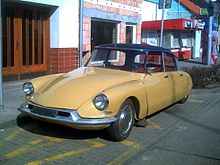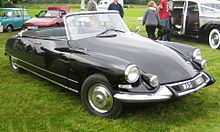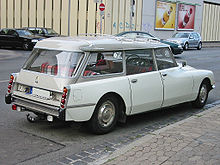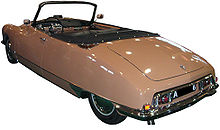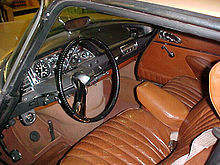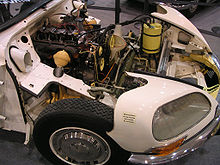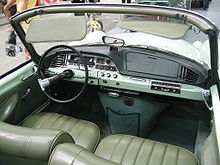- Citroën DS
-
Citroën DS 
Manufacturer Citroën Also called Citroën ID Production 1955–1975 Assembly Paris, France
Mangualde, Portugal
Slough, England
Heidelberg, Victoria, Australia
Johannesburg, South Africa
Koper, YugoslaviaPredecessor Citroën Traction Avant Successor Citroën CX Class Mid-size luxury car / Executive car Body style 4-door sedan
5-door Safari station wagon
2-door convertibleLayout MF layout Engine 1,911 cc (1.911 L; 116.6 cu in) I4
1,985 cc (1.985 L; 121.1 cu in) I4
2,175 cc (2.175 L; 132.7 cu in)109 hp[1] I4
2,347 cc (2.347 L; 143.2 cu in) I4Wheelbase 3,124 mm (123.0 in) [2] Length 4,826 mm (190.0 in) (saloon)
4,991 mm (196.5 in) (estate)Width 1,791 mm (70.5 in) Height 1,464 mm (57.6 in) (saloon)
1,537 mm (60.5 in) (estate)Curb weight 1,270 kg (2,800 lb)(saloon)
1,384 kg (3,050 lb)(estate)Related Citroën SM Designer Flaminio Bertoni The Citroën DS was an executive car produced by the French manufacturer Citroën between 1955 and 1975. Styled by Italian sculptor and industrial designer Flaminio Bertoni and the French aeronautical engineer André Lefèbvre, the DS was known for its aerodynamic futuristic body design and innovative technology, including a hydropneumatic self-levelling suspension.
The DS advanced achievable standards in automobile ride quality, handling, and braking.[3] Citroën sold nearly 1.5 million D-series during the model's 20-year production run. The DS came in third in the 1999 Car of the Century competition, recognizing the world's most influential auto designs, and was named the most beautiful car of all time by Classic & Sports Car magazine.[4]
Model history
After 18 years of secret development as the successor to the Traction Avant, the DS 19 was introduced on 5 October 1955 at the Paris Motor Show. In the first 15 minutes of the show, 743 orders were taken, and orders for the first day totalled 12,000.[5]
Contemporary journalists said the DS pushed the envelope in the ride vs. handling compromise possible in a motor vehicle.[6]
To a France still deep in reconstruction after the devastation of World War II, and also building its identity in the post-colonial world, the DS motor car was a symbol of French ingenuity.[citation needed] The DS was distributed to many territories throughout the world [7].
It also posited the nation's relevance in the Space Age, during the global race for technology of the Cold War.[original research?] Structuralist philosopher Roland Barthes, in an essay about the car, said that it looked as if it had "fallen from the sky".[8] An American advertisement summarised this selling point: "It takes a special person to drive a special car".[citation needed]
The high price tag, however, hurt general sales[citation needed] in a country still recovering from World War II, and a cheaper submodel, the Citroën ID, was introduced in 1957. The ID shared the DS's body but was less powerful. Although it shared the engine capacity of the DS engine (at this stage 1,911 cc), the ID provided a maximum power output of only 69 hp compared to the 75 hp claimed for the DS19.[9] Power outputs were further differentiated in 1961 when the DS19 acquired a Weber-32 twin bodied carburetter, and the increasing availability of higher octane fuel enabled the manufacturer to increase the compression ration from 7.5:1 to 8.5:1.[9] A new DS19 now came with a promised 83 hp of power.[9] The ID19 was also more traditional mechanically: it had no power steering and had conventional transmission and clutch instead of the DS's hydraulically controlled set-up. Initially the basic ID19 was sold on the French market with a price saving of more than 25% against the DS, although the differential was reduced at the end of 1961 when the manufacturer quietly withdrew the entry level ID19 "Normale" from sale.[9] A station wagon variant, the ID Break, was introduced in 1958.
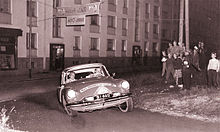 DS19 at the 1956 1000 Lakes Rally
DS19 at the 1956 1000 Lakes Rally
The ID19 followed the DS19's example in using a punning name. While "DS" is pronounced in French as "Déesse" (goddess), "ID" is pronounced as "Idée" (idea).
The DS was the first mass production car with front power disc brakes.[10] It also featured hydropneumatic suspension including an automatic leveling system and variable ground clearance, power steering and a semi-automatic transmission(the transmission required no clutch, but gears still had to be shifted by hand[11]), and a fibreglass roof which reduced weight transfer.[citation needed] Inboard front brakes (as well as independent suspension) reduced unsprung weight. Different front and rear track widths and tyre sizes reduced the understeer typical of front-engined and front-wheel drive cars.[citation needed]
As with all French cars, the DS design was affected by the tax horsepower system, which effectively mandated very small engines. Unlike the Traction Avant predecessor, there was no top-of-range model with a powerful six-cylinder engine. Citroën had planned an air-cooled flat-6 engine for the car, but did not have the funds to put the prototype engine into production. Despite the rather leisurely acceleration afforded by its small four-cylinder engine, derived from the Traction Avant, the DS was successful in motorsports like rallying, where sustained speeds on poor surfaces are paramount, and won the Monte Carlo Rally in 1959 and controversially in 1966, after the disqualification of the BMC Mini-Cooper team. In the 1000 Lakes Rally, Pauli Toivonen drove a DS19 to victory in 1962.
The DS placed fifth on Automobile Magazine's "100 Coolest Cars" listing in 2005.[12] It was also named the most beautiful car of all time by Classic & Sports Car magazine after a poll of 20 world-renowned car designers, including Giorgetto Giugiaro, Ian Callum, Roy Axe, Paul Bracq, and Leonardo Fioravanti.[4]
Technical innovation – hydraulic systems
In conventional cars, hydraulics are only used in brakes and power steering. In the DS they were also used for the suspension, clutch and transmission, although the later ID19 did have manual steering and a simplified power-braking system.
At a time when few passenger vehicles had independent suspension on all wheels, the application of the hydraulic system to the car's suspension system to provide a self-levelling system was an innovative move. This suspension allowed the car to achieve sharp handling combined with very high ride quality, frequently compared to a "magic carpet". The hydropneumatic suspension used was pioneered the year before, on the rear of another car from Citroën, the top of range Traction Avant 15CV-H.
Impact on Citroën brand development
The 1955 DS cemented the Citroën brand name as an automotive innovator, building on the success of the Traction Avant, which had been the world's first mass-produced monocoque front-wheel-drive car in 1934. In fact, the DS caused such a huge sensation that Citroën was apprehensive that future models would not be of the same bold standard. No clean sheet new models were introduced from 1955 to 1970.
The DS was a large, expensive executive car and a downward brand extension was attempted, but without result. Throughout the late 1950s and 1960s Citroën developed many new vehicles for the very large market segments between the 2CV and the DS, occupied by vehicles like the Peugeot 403, Renault 16 and Ford Cortina, but none made it into production. Either they had uneconomic build costs, or were ordinary "me too" cars, not up to the company's high standard of innovation. As Citroën was owned by Michelin as a sort of research laboratory, and were a powerful advertisement for the capabilities of the radial tyre Michelin had invented, such experimentation was possible.
Other models produced by Citroën were based on the utilitarian 2-cylinder 2CV economy car (that contained some of the most advanced independent suspension chassis engineering in the world). The Ami also designed by Flaminio Bertoni attempted to combine the styling of the DS with the advanced chassis of the 2CV. It was very successful in France in the 1960s, but less so on export markets because of its controversial styling, and by being noisy and underpowered. The Dyane, was a modernised 2CV with a hatchback, to compete with the Renault 4.
Citroën finally did introduce the Citroën GS in 1970, which won "European car of the Year 1970" and sold a spectacular 2.5 million units. But it was still underpowered by a flat-4 air-cooled engine, the intended Wankel rotary-engined version did not reach full production.
Replacing the DS
The DS remained popular and competitive throughout its production run. Its peak production year was 1970. Certain design elements like the somewhat narrow cabin, column mounted gearstick, and separate fenders began to seem a little old-fashioned in the 1970s.
Citroën invested enormous resources to design and launch an entirely new vehicle in 1970, the SM, which was a thoroughly modernized, much wider, faster and more expensive car than the DS. Although the SM construction was conceptually similar to the DS – a platform frame with many pieces spotwelded together, mid-engine, front-wheel drive, detachable front fenders, hydropneumatic suspension, rear fender skirts, and trailing arm rear suspension – it is an entirely different car. On the SM, the roof and rear quarter panels were welded on. Few parts are directly interchangeable between the two cars, but the DS and SM were both assembled on the same production lines at Quai André-Citroën, Paris. Unlike the DS, the factory never authorized a convertible model, as Citroën felt the roof was integral to the structure of the SM.
Despite all this, the SM had to fulfill another purpose beyond just modernizing the DS: it had to launch Citroën into a new grand tourer market segment. This meant that unlike the DS, the SM was not designed to be a practical 4-door saloon suitable as a large family car, the key market for vehicles of this type in Europe. Typically, manufacturers would introduce low-volume coupés based on parts shared with an existing saloon, not as unique models, a contemporary example being the Mercedes-Benz SLC-Class. The SM's high price, driven by its Maserati engine and limited utility of the 2+2 seating configuration, meant the SM as actually produced could not seize the mantle from the DS.
The DS was finally phased out in 1976, by which time 1,455,746 cars had been produced. The DS was replaced as the large family or executive car in the model range by the CX. The development and launch of the CX in the wake of the 1974 oil crisis, bankrupted Citroën[citation needed] and forced them into a merger with Peugeot, to form PSA Peugeot-Citroën.
Manufacture
The DS was primarily manufactured in Paris, with other manufacturing facilities in the United Kingdom, South Africa, the former Yugoslavia (mostly Break Ambulances), and Australia.
Australia constructed their own D variant in the 1960s at Heidelberg, Victoria, identified as the ID 19 "Parisienne." Australian market cars were fitted with options as standard equipment such as the "DSpecial DeLuxe" that were not available on domestic European models.
Until 1965 cars were assembled at the manufacturer's Slough premises, to the west of London, using a combination of French made semi CKD kits and locally sourced components, some of them machined on site.[13] A French electrical system superseded the British one on the Slough cars in 1962, giving rise to a switch to "continental style" negative earthing. After 1965 cars for the British market were imported fully assembled from the company's French plant.[13] The British-built cars are distinguished by their leather seats, wooden dashboards, and (on pre-1962 cars) Lucas-made electrics.
DS in the United States
The DS was sold in the United States from 1956 to 1972, over which time 38,000 units were sold. While the DS was popular in Europe, it didn't sell well in the United States. Ostensibly a luxurious car, it did not have the basic features that buyers expected to find on such a vehicle: fully automatic transmission, air conditioning, power windows, and a powerful engine. The DS's price in 1970 ranged from US$4,066 to US$4,329.[14]
Also, American luxury-car buyers at the time were conditioned to show off their new cars, the design details of which were changed every model year as a kind of stylistic planned obsolescence, but the DS' appearance did not change substantially in the 16 years it was available in the States.
US regulations at the time banned one of the car's more advanced features, its composite headlamps with aerodynamic cover lenses. At the time, all vehicles sold in the US had to have standard-size sealed beam headlamps; composite replaceable-bulb lamps weren't permitted until late 1983. And cover lenses, even clear ones, are not legal in the US. The first year of aerodynamic glass enclosing the headlamps on the DS was also the first year that feature was outlawed in the US: 1968.
Design variations
The DS always maintained its size and shape, with easily removable, unstressed body panels, but certain design changes did occur.
A station wagon version was introduced in 1958. It was known by various names in different markets (Break in France, Safari and Familiale in the UK, Wagon in the US, and Citroën Australia used the terms Safari and Station-Wagon). It had a steel roof to support the standard roof rack.
In September 1962, the DS was restyled with a more aerodynamically efficient nose, better ventilation and other improvements. It retained the open two headlamp appearance, but was available with an optional set of driving lights mounted on the front fenders. In 1965 a luxury upgrade kit, the DS Pallas (after Greek goddess Pallas), was introduced. This included comfort features such as better noise insulation, a more luxurious (and optional leather) upholstery and external trim embellishments.
In 1967, the DS and ID was again restyled. This version had a more streamlined headlamp design, giving the car a notably shark-like appearance. This design had four headlights under a smooth glass canopy, and the inner set swivelled with the steering wheel. This allowed the driver to see "around" turns, especially valuable on twisting roads driven at high speed at night.
However, this feature was not allowed in the US at the time (see World Forum for Harmonization of Vehicle Regulations), so a version with four exposed headlights that did not swivel was made for the US market.
The station wagon edition, the Break (called the ID Safari on the UK market) and "Familiale", was also upgraded. The hydraulic fluid changed to the technically superior LHM (Liquide Hydraulique Minéral) in all markets except the US.
Rarest and most collectable of all DS variants, a convertible was offered from 1958 until 1973. The convertibles were built in small series by French carrossier Henri Chapron, for the Citroën factory. The DS convertibles used the break (station wagon) frame, which was reinforced on the sidemembers and rear suspension swingarm bearing box.
In addition, Chapron also produced a few coupés, non-works convertibles and special sedans (including the 'Prestige,'[1] same wheelbase but with a with a central divider, and the 'Lorraine' notchback).
In 1965, noted American auto customizer Gene Winfield created The Reactor, a two-seat Citroen DS with a turbocharged 180 horsepower Corvair engine driving the front wheels, and a streamlined aluminum body.[15] This vehicle was seen in TV programs of the era, such as Batman episodes 110 ("Funny Feline Felonies") and 111 (driven by Catwoman Eartha Kitt),[16] Bewitched, which devoted the episode 3.19 ("Super Car") to the Reactor, and Star Trek episode 54 ("Bread and Circuses").[17]
Technical details
Suspension
In a hydropneumatic suspension system, each wheel is connected, not to a spring, but to a hydraulic suspension unit consisting of a sphere of about 12 cm in diameter containing pressurised nitrogen, a cylinder containing hydraulic fluid screwed to the suspension sphere, a piston inside the cylinder connected by levers to the suspension itself, and a damper valve between the piston and the sphere. A membrane in the sphere prevented the nitrogen from escaping. The motion of the wheels translated to a motion of the piston, which acted on the oil in the nitrogen cushion and provided the spring effect. The damper valve took place of the shock absorber in conventional suspensions. The hydraulic cylinder was fed with hydraulic fluid from the main pressure reservoir via a height corrector, a valve controlled by the mid-position of the anti-roll bar connected to the axle. If the suspension was too low, the height corrector introduced high-pressure fluid; if it was too high, it released fluid back to the fluid reservoir. In this manner, a constant ride height was maintained. A control in the cabin allowed the driver to select one of five heights: normal riding height, two slightly higher riding heights for poor terrain, and two extreme positions for changing wheels. [The correct term oleopneumatic (oil-air) has never gained widespread use. Hydropneumatic (water-air) continues to be preferred overwhelmingly.]
The DS did not have a jack for lifting the car off the ground. Instead, the hydraulic system enabled wheel changes with the aid of a simple adjustable stand. To change a flat tyre, one would adjust the suspension to its topmost setting, insert the stand into a special peg near the flat tyre, then readjust the suspension to its lowermost setting. The flat tyre would then retract upwards and hover above ground, ready to be changed. This system, used on the SM also, was superseded on the CX by a screw jack that, after the suspension was raised to the high position, lifted the tire a fraction of an inch off the ground. The DS system, while impressive to use, sometimes dropped the car quite suddenly, especially if the stand was not placed precisely or the ground was soft or unlevel.
Source and reserve of pressure
The central part of the hydraulic system was the high pressure pump, which maintained a pressure of between 130 and 150 bar in two accumulators. These accumulators were very similar in construction to the suspension spheres. One was dedicated to the front brakes, and the other ran the other hydraulic systems. (On the simpler ID models, the front brakes operated from the main accumulator.) Thus in case of a hydraulic failure, the first indication would be that the steering became heavy, followed by the gearbox not working; only later would the brakes fail.
Hydraulic fluid
The original hydropneumatic system used a vegetable oil liquide hydraulique végétal (LHV), similar to that used in other cars at the time. Later, Citroën changed to using a synthetic fluid liquide hydraulique synthétique (LHS). Both of these had the disadvantage that they are hygroscopic, as is the case with most brake fluids. Disuse allows water to enter the hydraulic components causing deterioration and expensive maintenance work. The difficulty with hygroscopic hydraulic fluid was exacerbated in the DS/ID due to the extreme rise and fall in the fluid level in the reservoir, which went from nearly full to nearly empty when the suspension extended to maximum height and the six accumulators in the system filled with fluid. With every "inhalation" of fresh moisture- (and dust-) laden air, the fluid absorbed more water. In August 1967, Citroën introduced a new mineral oil-based fluid liquide hydraulique minéral (LHM). This fluid was much less harsh on the system. LHM remained in use within Citroën until the Xantia was discontinued in 2001.
LHM required completely different materials for the seals. Using either fluid in the incorrect system would completely destroy the hydraulic seals very quickly. To help avoid this problem, Citroën added a bright green dye to the LHM fluid and also painted all hydraulic elements bright green. The former LHS parts were painted black.
Two different hydraulic pumps were used. The DS used a seven-cylinder axial piston pump driven off two belts and delivering 175 bar (2,540 psi) of pressure. The ID19, with its simpler hydraulic system, had a single-cylinder pump driven by an eccentric on the camshaft.
Gearbox and clutch
The mechanical aspects of the gearbox and clutch were completely conventional and the same elements were used in the ID 19. The gear change control though, consisted of a hydraulic gear selector, and clutch control. The speed of engagement of the clutch was controlled by a centrifugal regulator sensing engine rpm and driven off the camshaft by a belt, the position of the butterfly valve in the carburettor (i.e., the position of the accelerator), and the brake circuit. When the brake was pressed, the engine idle speed dropped to an rpm below the clutch engagement speed, thus preventing friction while stopped in gear at traffic lights. When the brake was released, the idle speed increased to the clutch dragging speed. The car would then creep forward much like automatic transmission cars. This drop in idle throttle position also caused the car to have more engine drag when the brakes were applied even before the car slowed to the idle speed in gear, preventing the engine from pulling against the brakes.
Engines
The DS was originally designed around an air-cooled flat-six based on the design of the 2-cylinder engine of the 2CV, similar to the motor in the Porsche 911. Technical and monetary issues forced this idea to be scrapped.
Thus, for such a modern car, the engine of the original DS 19 was also old-fashioned. It was derived from the engine of the 11CV Traction Avant (models 11B and 11C). It was an OHV four-cylinder engine with three main bearings and dry liners, and a bore of 78 mm (3.1 in) and a stroke of 100 mm (3.9 in), giving a volumetric displacement of 1911 cc. The cylinder head had been reworked; the 11C had a reverse-flow cast iron cylinder head and generated 60 hp (45 kW) at 3800 rpm; by contrast, the DS 19 had an aluminium cross-flow head with hemispherical combustion chambers and generated 75 hp (56 kW) at 4500 rpm. Apart from these details, there was very little difference between the engines: even the locations of the cylinder head studs were the same, so that it was possible to put the cylinder head of a DS on a Traction Avant engine and run it.[citation needed]
Like the Traction Avant, the DS had the gearbox mounted in front of the engine, with the differential in between. Thus some consider the DS to be a mid engine front-wheel drive car. It initially had a four-speed gearbox and clutch, operated by a hydraulic controller. To change gears, the driver flicked a lever behind the steering wheel to the next position and eased-up on the accelerator pedal. The hydraulic controller disengaged the clutch, engaged the nominated gear, and re-engaged the clutch.
The DS and ID powerplants evolved throughout its 20-year production life. The car was underpowered and faced constant mechanical changes to boost the performance of the four-cylinder engine. The initial 1911 cc 3 main bearing engine (carried forward from the Traction Avant) of the DS 19 was replaced in 1965 with the 1985 cc 5-bearing motor of the DS 19a (called DS 20 from September 1969).
The DS 21 was also introduced for model year 1965. This was a 2175 cc, 5 main bearing engine. This engine received a substantial increase in power with the introduction of Bosch electronic fuel injection for 1970, making the DS one of the first mass-market cars to use electronic fuel injection.
Lastly, 1973 saw the introduction of the 2347 cc engine of the DS 23 in both carbureted and fuel injected forms. The DS 23 with electronic fuel injection was the most powerful production model, producing 143 hp (107 kW).
IDs and their variants went through a similar evolution, generally lagging the DS by about one year. ID models never received the DS 23 engine or fuel injection.
The DS was initially offered only with the "hydraulique" 4-speed semi-automatic (bvh-"boîte de vitesses hydraulique") gearbox. The later and simpler ID19 had the same gearbox and clutch, manually operated. This configuration was offered as a cheaper option for the DS in the mid-1960s. In September 1970 Citroën introduced a 3-speed fully automatic Borg-Warner and a five-speed manual gearbox, in addition to the original four-speed unit.[18] The full-automatic transmissions were intended for the US market, but as Citroën withdrew from the US in 1972, the year of highest US sales, due to constrictive road rules, most automatic DSs, fuel-injected DS 23 sedans with air conditioning, were sold in Australia.
Directional headlights
 Directional headlamp detail of a DS21
Directional headlamp detail of a DS21
Directional headlamps were introduced as an option on the DS in September 1967 (standard on the Pallas model) for the first time on a Citroën. Behind each glass cover lens, the inboard high-beam headlamp swivels by up to 80° as the driver steers, throwing the beam along the driver's intended path rather than uselessly across the curved road. The outboard low-beam headlamps are self-leveling in response to pitching caused by acceleration and braking.[citation needed]
DS in popular culture
The DS has been used in many film and television productions,[19] has inspired artists, and was associated with the French state and French society for many years. The movie The Goddess of 1967 was named after the DS. The movie is about a 1967 DS or goddess (déesse in French).
In the post-World War II environment of the 1950s, the DS was a significant advertisement for French manufacturing and ingenuity. President Charles de Gaulle praised the unusual abilities of his unarmoured DS with saving his life during the assassination attempt at Petit-Clamart on 22 August 1962 planned by Jean-Marie Bastien-Thiry — the shots had blown two of the tyres, but the car could still escape at full speed. This event was accurately recreated for The Day of the Jackal.
DS today
Citroën DS values have been rising – a 1973 DS 23 Injection Electronique 'Decapotable' (Chapron Convertible) sold for EUR €176,250 (USD $209,738) at Christie's Retromobile in February 2006.[20] and a similar car sold by Bonhams in February 2009 brought EUR €343,497 (USD $440,436). [2] On 18 September 2009 a 1966 DS21 Decapotable Usine was sold by Bonhams for a hammer price of UK £131,300. Bonhams sold another DS21 Decapotable (1973) on 23 January 2010 for EUR €189,000 [3]
The DS's beloved place in French society was demonstrated in Paris on 9 October 2005 with a celebration of the 50th anniversary of its launch. 1,600 DS cars drove in procession past the Arc de Triomphe.[21]
Le Monde reported on February 2, 2009 that Peugeot Citroën would re-introduce the DS to the car market in 2010.[22] It has since been revealed that the DS will in fact be a range of, to begin with, three cars, headed by the small 'DS3'. These cars will be high quality, high specifications variations on existing models, but with differing mechanics and bodywork. The DS3, launched in March 2010, is based on Citroen's new C3, but is more customisable and unique, bearing resemblances to the original DS, with its 'Shark Fin' side pillar. In 2010 and 2011, Citroen will launch the DS4 and DS5, models to sit above the C4 and C5 ranges respectively. Both are expected to be more innovative than the DS3, which received mixed feelings from critics and fans at its launch, and are expected to feature hybrid-diesel engines to maximise efficiency, as well as other things that have been seen on Citroen's most recent concept cars.
Production figures for all DS models
- 1955 – 69
- 1956 – 9,868
- 1957 – 28,593
- 1958 – 52,416
- 1959 – 66,931
- 1960 – 83,205
- 1961 – 77,597
- 1962 – 83,035
- 1963 – 93,476
- 1964 – 85,379
- 1965 – 89,314
- 1966 – 99,561
- 1967 – 101,904
- 1968 – 81,860
- 1969 – 82,218
- 1970 – 103,633
- 1971 – 84,328
- 1972 – 92,483
- 1973 – 96,990
- 1974 – 40,039
- 1975 – 847[23]
References
- ^ Willson, Quentin (1995). The Ultimate Classic Car Book. DK Publishing, Inc.. ISBN 0-7894-0159-2.
- ^ Cardew, Basil (1966). Daily Express Review of the 1966 Motor Show. London: Beaverbrook Newspapers Ltd.
- ^ "Citroen DS – A car years ahead of its time". retrothing.com. http://www.retrothing.com/2007/01/citroen_ds_deca.html. Retrieved 2007-09-06.
- ^ a b "1955 Citroen DS – The Most Beautiful Car of All Time". Motorcities.com. http://www.motorcities.com/vehicle/09B4E032327279.html. Retrieved 2009-07-09.
- ^ "The Most Incredible Car Ever Built". egothemag.com. http://www.egothemag.com/archives/2004/10/citroen_ds_1.htm. Retrieved 2007-09-06.
- ^ "Drive: 1960 Citroen DS". motortrend.com. http://www.motortrend.com/classic/roadtests/c12_0511_1960_citroen_ds/suspension_engine.html. Retrieved 2007-09-06.
- ^ http://www.dsinasia.com
- ^ "The New Citroen by Roland Barthes 1957". id-ds.com. Archived from the original on 2007-08-16. http://web.archive.org/web/20070816121741/http://www.id-ds.com/PlanetD&G/barthes.but.html. Retrieved 2007-09-06.
- ^ a b c d "Automobilia". Toutes les voitures françaises 1962 (salon Paris oct 1961) (Paris: Histoire & collections) Nr. 19: Page 15. 1200.
- ^ "Citroën DS". vintagecars.about.com/internet archive. Archived from the original on 2007-01-04. http://web.archive.org/web/20070104231250/http://vintagecars.about.com/od/historygreatmoments/a/citroen_ds.htm. Retrieved 2007-09-06.
- ^ Willson, Quentin (1995). The Ultimate Classic Car Book. DK Publishing, Inc.. ISBN 0-7894-0159-2.
- ^ "Automobile Magazine – 100 Coolest Cars". http://www.automobilemag.com/features/0410_coolest_cars/stingray.html. Retrieved 2008-07-29.
- ^ a b "Spot check: The Citroen D-Type". Motor: pages 38–40. 21 August 1971.
- ^ www.nadaguides.com
- ^ Grant, David (2008). The Legendary Custom Cars and Hot Rods of Gene Winfield. Motorbooks. ISBN 978-0-7803-2778-4.
- ^ http://www.breakdowncover.org/blog/9-coolest-batman-vehicles
- ^ http://memory-alpha.org/wiki/Jupiter_8
- ^ "Original Citroën DS", John Reynolds, Bay View Books, 1996, ISBN 1-870979-71-0
- ^ IMCDb: Citroën DS in movies
- ^ 2006 Retromobile – Report and Slideshow
- ^ "Citroen 'goddess' feted in Paris". BBC News. 2005-10-09. http://news.bbc.co.uk/2/hi/business/4324668.stm. Retrieved 2010-04-30.
- ^ Le Monde | Economie | Citroën s'apprêterait à relancer la production de DS
- ^ John Reynolds: "Original Citroën DS", Bay View Books, 1996, page 135
Further reading
- Reynolds, John (1996), Original Citroën DS, Bay View Books, ISBN 1-870979-71-0
- Road & Track magazine, USA. June, 1958
External links
- Citroën D Series at Citroënët
- Citroen DS at the Internet Movie Cars Database
Type 1950s 1960s 1970s 0 1 2 3 4 5 6 7 8 9 0 1 2 3 4 5 6 7 8 9 0 1 2 3 4 5 6 7 8 9 Economy car 2CV Off-roader Méhari Supermini LN / LNA Dyane Ami Visa Small family car GS Large family car 11 CV ID / DSpécial / DSuper Executive car 15 CV DS CX Grand tourer SM Citroën PSA Peugeot Citroën · Category · Vehicles
Current - Europe Current - China (DPCA) Historic Trucks Concept cars G Van · Prototype C · Prototype Y · 2CV Pop · GS Camargue · C44 · Karin · Zabrus · Activa · C6 Lignage · C-SportLounge · C-Airplay · C-Buggy · C-Airdream · GT by Citroën · Hypnos · DS Inside · Revolte · Survolt · C-CactusMotorsport Electric vehicle Categories:- Citroën vehicles
- Front wheel drive vehicles
- Industrial designs
- Executive cars
- Convertibles
- Sedans
- Station wagons
- Vehicles introduced in 1955
- 1950s automobiles
- 1960s automobiles
- 1970s automobiles
Wikimedia Foundation. 2010.

